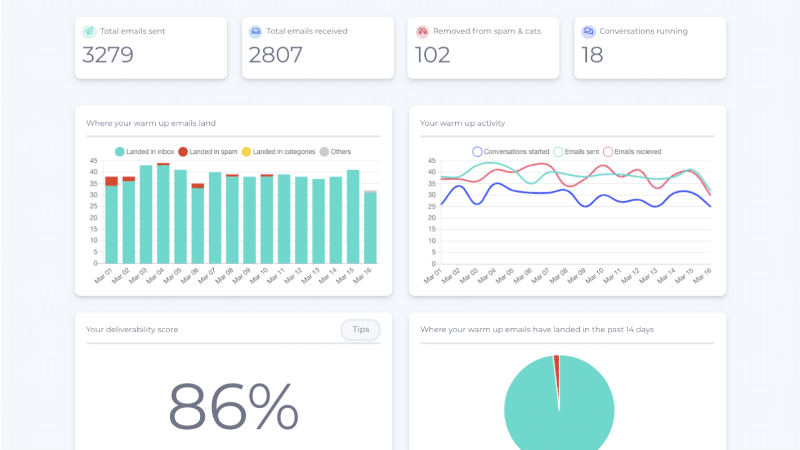
Email Marketing And Email Warmup
So what is email warmup, and why should you do it?
OK. This is pretty complex, but I'll keep things as simple as possible. But if you do any kind of email marketing for yourself or via a third party (like us), you need to understand this, so stick with it.
In this blog post, we're going to use a made-up person and company name, let's use Dave, and a company called Big Wings. So Dave's email address is dave@bigwing.com.
Whenever you send an email, either a quick personal or business one, or one that's part of a bulk email campaign, that email routes through a lot of services on the internet, these services are run by the likes of Yahoo, Google, Microsoft, and so on. As these services transition the email from you to its recipient, they check for spam. If any thinks your message is spam, it'll get flagged as such and so more than likely end up in your recipient's spam folder. This is, of course, bad.
One of the critical factors these services use to judge if the message is spam or not is the sender's reputation. This reputation is built over time: The more "good" messages sent from the email address that get replies from the recipients (yes, these services monitor this!), the better the reputation.
"No problem, I'm going to send my email marketing from my regular email address, which I've used for years, so we're golden." You think. But you are not.
Sending bulk emails from your regular email address is a terrible idea. The reason is that it's highly likely your business email address is linked to your website address, like dave@bigwing.com. So if more than a few recipients of your bulk email campaign sent from your regular email address, click the SPAM link on your email, your email address, and so the address of your website (bigwing.com) can get flagged. Get too many of these, and your website can get blacklisted.
Think about that for a moment. In this example of Dave, his business website www.bigwing.com has been blacklisted because some people clicked SPAM on his email campaign. This means, at best, his site will drop down or even disappear from search results. Or worse, every visitor to his site gets hit with a message warning them that the site they are about to visit might be a scam site trying to steal their data.
This is not me blowing things up out of proportion. This is a real-world reality. I've seen it happen. I've seen online businesses destroyed overnight because they didn't take the following advice.
How to avoid this?
It's pretty simple. It just takes a bit of time and some expense.
First off... Never ... NEVER send bulk email campaigns via an email address connected to your business website. Buy a "burner" domain (typically £20 a year) that is similar but not identical. So in this example, Dave could buy big-wing.com (note the dash). Then he sets up an email address on this domain, like news@big-wing.com. So now, if the worst happens and big-wing.com gets blacklisted, he dumps it and buys another one, like big-wing.net or similar. Crucially though, his business domain, bigwing.com, isn't affected.
So now you are sorted with your burner domain and all setup, ready to go. But wait... Remember that thing about email reputation? Your new email address on your burner domain has zero reputation, and you are about to start sending hundreds or even thousands of emails via it. What's going to happen?
I can tell you EXACTLY what will happen. The email services mentioned above will spot the new domain name, see it's gone from zero to thousands of emails in a single day, and they'll work out exactly what you're doing and immediately flag it as spam. So all the money you spend on your mailing list and your campaign will amount to diddly squat because all your emails will get tagged SPAM. Well, OK, not all, but a lot.
DON'T PANIC! There is a solution. It's called Email Warmup.
Email warmup is a clever little system that takes your new email address connected to your new burner domain and automatically sends emails from it. Starting with just a few on the first day to several hundred on the last day (it typically takes 30-90 days to fully warm up a new email address).
That's not that clever, you say? Fair. The clever bit is that these emails are replied to automatically without human intervention. Warming up an email via an automated service means emails are sent AND responded to multiple times a day, over extended periods, to actual email inboxes.
This means that after a month or so, your new email address has an excellent reputation with the email services on the web. When you eventually start to send your campaigns, you have a much better chance of landing in inboxes, not spam folders.
How much better a chance? We estimate sending campaigns from cold email addresses results in about 50% hitting spam. With a warmed-up address, the success rate of emails hitting inboxes is around 80%. And the more your campaign emails land in inboxes, the more business the campaign can generate.
What next?
If we are about to start an email campaign for you, we can sort out your new burner domain, set up a new email address and get it warmed up for you. Typically this costs about £15 / €20 a month for the warmup period, with an initial setup fee of around £50 / €60. We only offer this service to clients we run campaigns for.
If you are running your own campaigns or have someone else do it, just Google "email warmup", and you'll get a long list of services. Some of these are good, some not so. So do some research before spending your money!